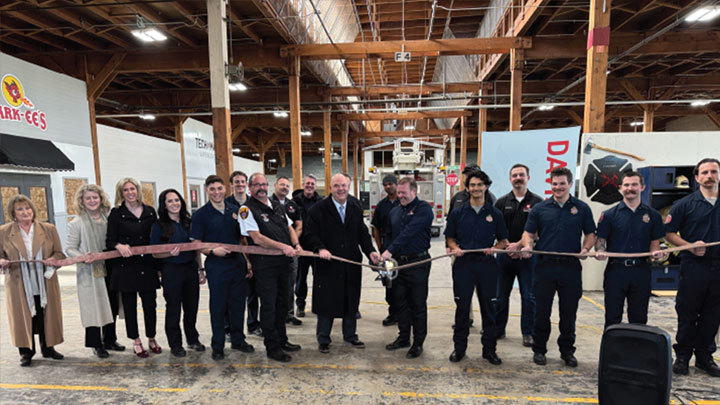Davis Tech Launches New Fire Academy for their Emergency Services Programs

At a ribbon-cutting ceremony today, Davis Technical College (Davis Tech) opened a new Emergency Services Training Lab at their Freeport West building in Clearfield, Utah. In true firefighter tradition, there was no ribbon or scissors; instead, a fire hose was cut using the Jaws of Life.
“It’s the beginning of a new era for the students at Davis Tech. With this new Fire Academy extension, our students can accomplish 70% of their training right here,” said Jared Sholly, Davis Tech Emergency Services Training Officer/Course Coordinator. “This has been my vision and dream for over ten years, and I’m delighted to see the students using it.”
Sholly started at Davis Tech in 1999 as an Emergency Medical Technician (EMT) instructor. In 2007, since the closest fire academies were in Logan and Provo, Davis Tech started a firefighter training program to support the Weber and Davis County fire departments. Since then, there have been 37 cohorts, with 48 firefighter students scheduled to graduate this year. Students will learn their initial skills in this lab before advancing to the Layton City Fire Training Center, where they can participate in live fire scenarios.
The training lab has nine stations dedicated to various scenarios for learning critical life-saving skills. There are three structures: a residence with a collapsible hallway floor, a small convenience store with alleyway entry, and a large box store with movable walls to vary the exercises. Some additional training tools include a forcible entry door, two roof styles, a vehicle, and a fire truck donated by the North Summit Fire District.
Previous students were on hand to demonstrate various skills and to answer questions. Gannon O’Mally, a Roy City firefighter and previous Davis Tech academy chief, shared, “This new fire academy building is well thought out to include props that keep students on their toes and will open students’ eyes to what can happen in real life. This will turn out some great firefighters!”
Isaiah Thorne, a recent Davis Tech graduate and member of the Utah National Guard, added, “This is a much more dynamic space. With the moveable walls, it’s a whole new building each time. It’s great for experiencing onsite situational awareness. You never know what type of situation you are heading into.”
Representatives from many fire departments in Weber and Davis County attended the event to view the new academy space and show support.
Mark Becraft, North Davis Fire District Chief, who has long supported Davis Technical College, says his fire departments ‘snag’ firefighters from the Davis Tech academy as often as they can. Becraft also said, “I’ve seen a lot of training facilities, and this one is top tier, the best in the area. We will be using it for future training.”
The architect for this training center is Onyx Design Collective, and the contractor is Mike Funk Construction.
The Larry H. & Gail Miller Family Foundation is the signature sponsor. Major sponsors include Chevron, Sorenson Legacy Foundation, Jewel Lee Kenley, and North Summit County Fire Department.
"We are proud to support the Davis Technical College Emergency Services Training Lab,” said Don Stirling, executive director of the Larry H. & Gail Miller Family Foundation. “This state-of-the-art training facility represents a significant investment in the future of our emergency services, equipping first responders with the skills and resources they need to protect and serve our communities. We are honored to be part of this milestone, reinforcing our commitment to fostering technical education and the well-being of our communities.”
“Teaching our first responders over the last twenty-five years has been an honor and privilege. I have witnessed many of our students change the life of someone during that person’s worst moment,” said Sholly. “We as instructors take our job very seriously, knowing that one day the life of a patient, victim or firefighter may hinge on the initial training a student received.”
